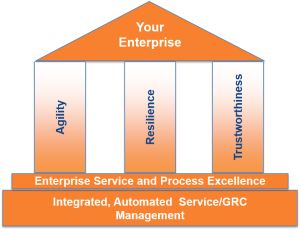
As we explained in our last blog Your Enterprise as a Work of “ART”, to become more “ART-ful,” your enterprise must become more agile, resilient, and trustworthy. This post digs a bit more deeply into what business agility is, why it
matters, and how to achieve and sustain it.
According to the book, “Built to Change: How to Achieve Sustained Organizational Effectiveness,” between 1973 and 1983, 35 percent of the top 20 Fortune 1000 companies were new to that list. That percentage of new top 20 companies grew to 45 percent between 1983 and 1993, and to 60 percent between 1993 and 2003.
Many if not most of the companies displaced by newcomers to the Fortune 1000 top 20 not only fell to lower positions, but ceased to exist entirely. It is arguable that like the dinosaurs, many of these companies failed to survive because they could not adapt to roiling, unexpected change. In other words, they were not sufficiently agile.
But simple, reactive adaptability is just one part of true agility. The Center for Effective Organizations (CEO) at the University of Southern California has conducted its Organization Agility Research Program for more than 10 years. The Center published its first book, “The Agility Factor: Building Adaptable Organizations for Superior Performance,” in August 2014. In that work, the Center’s experts argue that agility is both more dynamic and more proactive than reactive adaptability or even what’s traditionally viewed as “change management.”
Among the 234 enterprises the Center studied, “consistently high performers possess a capability to change their resources and processes repeatedly.” Such enterprises also “have the strategies, structures, resources, processes, and routines that allow them to both sense and adapt to environmental threats and opportunities as well as intentionally execute on strategic initiatives.”
Agility: A Bottom-Line Benefit
Agility also has a direct and positive effect on an enterprise’s bottom line, the Center found in a 2012 study. For that research, the Center evaluated the financial performance of 243 large firms across 17 industries over the 30-year period.
“In every industry we studied, there were two or three ‘outperformers’: companies that achieved above-average industry ROA performance more than 80 percent of the time. When we compared our survey and interview data with the performance data, we observed a strong relationship between a company’s basic approach to management and its long-term profitability patterns. When markets and technologies changed rapidly and unpredictably—as they did in every industry over these 30 years—the outperformers had the capability to anticipate and respond to events, solve problems, and implement change better than thrashers. They successfully adapted. They were agile.”
Read: “Enterprise Service and Process Excellence: What It Is and How to Get It.”
How to Achieve and Sustain Agility
- Start at the top. Agility can be built from the ground up, but the will and commitment to become and remain agile must come from enterprise leadership. This means that executives, and IT, GRC, and business unit leaders must be visibly and demonstrably behind agility-related initiatives.
- Walk the talk. Commitments to agility must extend beyond platitudes and media quotes. Every strategic plan and set of operational practices and principles must reflect and support that commitment for it to mean anything to your enterprise. (This means that every such resource must incorporate processes for regular review and the opportunity for revision in response to corporate, marketplace, or regulatory changes.)
- Build it in. Every process and control upon which your enterprise’s competitiveness depends must incorporate agility-enhancing elements. This means that those processes and controls must be driven by and measured against your enterprise’s performance requirements and goals. Controls and processes that are not focused on enterprise performance will likely contribute little to your organization’s agility, and might even impede it. (This means that all controls and processes must be reviewed and tested regularly, and designed to be easily modified or retired as changes demand.)
- Be agile everywhere. Agility may be initially fomented in one or more departments or business units. But for maximum business benefit, it must be pervasive. For many enterprises, possibly including yours, the best way to make this happen is to start with IT. Since IT delivers services to the rest of the enterprise, agility-related initiatives that prove successful within IT can be incorporated into the delivery and management of those services. This means that a single, integrated, process-driven platform for service management and delivery can be a powerful enabler of enterprise agility.
Read: Four Reasons Why You Can (and Should) Enable Both Your ITSM and GRC Objectives on One ServiceNow Platform
Agility is an operational and competitive requirement for every successful enterprise. By taking concrete steps toward fomenting an agility-minded culture, you can ease and accelerate your enterprise’s journey to true, sustainable agility.
Next up: resilience. And no, it’s not just about disaster recovery and business continuity. Meanwhile, your thoughts and reactions are welcome!
